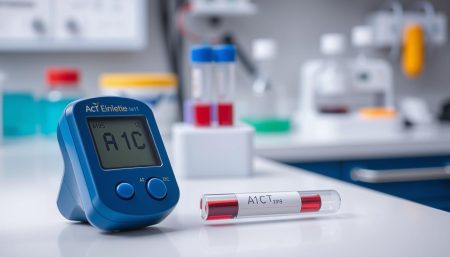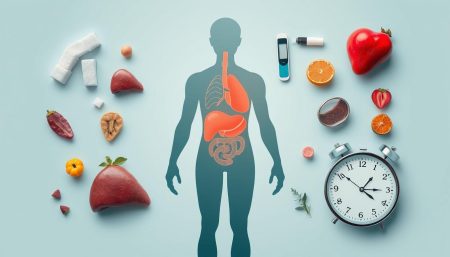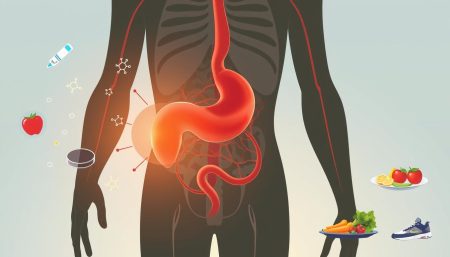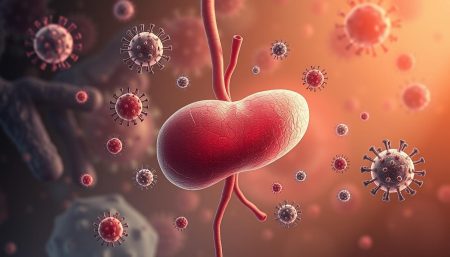We explore the complex world of type II diabetes mellitus pathophysiology. It’s a journey into the body’s metabolic processes and how they go wrong. This leads to high blood sugar levels that last a long time.
Understanding type 2 diabetes is key for doctors, researchers, and patients. This article breaks down the biological and systemic issues. It covers insulin resistance and the decline in beta cell function, key to type ii diabetes mellitus pathophysiology.
Understanding Type II Diabetes Mellitus Pathophysiology
To understand type 2 diabetes, we must look at several biological factors. These include insulin resistance, beta cell dysfunction, and problems with handling lipids and glucose. These are the main causes of the disease.
Genetics and lifestyle play big roles in developing type 2 diabetes. Knowing how these factors work together helps us find better ways to manage and treat the disease.
The Biological Mechanisms Behind Type 2 Diabetes
Type 2 diabetes often begins with insulin resistance. This means the body’s cells don’t respond well to insulin. The pancreas then works harder to make more insulin, stressing the beta cells.
Understanding these diabetes mellitus type 2 mechanisms shows us where we can intervene. This could slow down or stop the disease from getting worse.
Key Concepts in Type II Diabetes Pathogenesis
Glucose and lipid toxicity are also key in type 2 diabetes. High blood sugar and lipid levels harm the pancreas and make insulin resistance worse. This is why keeping the pancreas healthy and managing blood sugar and cholesterol is so important.
Learning about how high cholesterol affects heart health is also important. This is because heart disease is common in people with diabetes. For more information, check out this article on cholesterol and heart.
| Factor | Role in Type 2 Diabetes | Impact |
|---|---|---|
| Insulin resistance | Initial phase | Cells fail to use insulin effectively |
| Beta cell stress | Compensatory hyperinsulinemia | Eventually leads to cell exhaustion |
| Glucose toxicity | Chronic hyperglycemia | Impairs insulin secretion and action |
| Lipotoxicity | Excess lipid levels | Exacerbates insulin resistance |
By understanding and managing these factors, we can slow down type 2 diabetes. This improves patients’ lives and quality of life.
Insulin Resistance in Type 2 Diabetes
The main issue with insulin resistance in type 2 diabetes is that the body’s cells don’t respond well to insulin. This is key for taking up glucose. This problem not only leads to type 2 diabetes but also affects hyperglycemia in type 2 diabetes. Let’s dive into the main points and what they mean for diabetes.
- Insulin resistance often starts before you’re diagnosed with type 2 diabetes. It’s a sign that things might get worse.
- Long-term insulin resistance puts more stress on the pancreas. This can make it hard for the pancreas to keep up.
- When insulin doesn’t work well, blood sugar levels go up. This is the start of long-term high blood sugar.
Knowing how this happens is key to managing and maybe even reversing type 2 diabetes. Making healthy lifestyle choices and eating right can help a lot.
The pathophysiology of hyperglycemia in type 2 diabetes is part of a bigger problem. It’s linked to other metabolic issues. This shows why treating diabetes needs a complete approach. Starting early and preventing diabetes can lead to better health.
The Role of Beta Cells in Type 2 Diabetes
Understanding beta cells in the pancreas is key to understanding type 2 diabetes. These cells make and release insulin, a hormone vital for glucose use. When there are fewer or less functional beta cells, beta cell dysfunction in type 2 diabetes occurs, a major part of the disease.
In type 2 diabetes, beta cells don’t make enough insulin when blood sugar is high. This problem comes from having fewer beta cells and the ones left not working well. Many factors, like genes and molecular changes, affect how well beta cells work.
- Progressive loss of beta cell mass
- Insulin secretory defects
- Intrinsic cellular dysfunction within beta cells
- Genetic susceptibility that predisposes individuals to beta cell dysfunction
Trying to keep beta cells working is important in managing type 2 diabetes. Scientists are looking into ways to help beta cells grow back or work better. This could lead to new treatments for the disease.
Metabolic Syndrome’s Connection to Type 2 Diabetes Etiology
Metabolic syndrome and type 2 diabetes are closely linked. Metabolic syndrome is a group of risk factors that raise the risk of getting type 2 diabetes. These factors include high blood pressure, high blood sugar, too much belly fat, and bad cholesterol levels.
This section explores how metabolic syndrome leads to type 2 diabetes.
Interplay Between Obesity and Type 2 Diabetes
Obesity, mainly around the waist, is a key part of metabolic syndrome. It plays a big role in type 2 diabetes. Too much belly fat makes it harder for the body to use insulin well.
The fat in obese people’s bodies is not just for storage. It’s also an active part that makes substances that can mess with glucose and insulin, making diabetes more likely.
How Metabolic Syndrome Contributes to Hyperglycemia
Metabolic syndrome affects how the body handles glucose, leading to high blood sugar. This is a big sign of type 2 diabetes. Insulin resistance, a big part of metabolic syndrome, makes it hard for cells to take in glucose.
This leads to high blood sugar levels. Over time, this can hurt the pancreas’s beta cells, making diabetes risk even higher.
| Condition | Impact on Insulin Sensitivity | Contribution to Type 2 Diabetes |
|---|---|---|
| Increased Blood Pressure | May exacerbate insulin resistance | Indirectly influences the development of diabetes |
| High Blood Sugar | Direct impact on glucose metabolism | Key factor in diabetes onset |
| Excess Abdominal Fat | Significantly reduces insulin sensitivity | Direct and significant contributor to diabetes |
| Abnormal Cholesterol Levels | Impairs cellular functions and insulin signaling | Contributes to chronic conditions linked with diabetes |
Genetic and Environmental Factors in Type 2 Diabetes
The mix of genetic predisposition and environmental factors is key to understanding type 2 diabetes etiology. Both play a role on their own and together, raising the risk of this chronic disease. We’ll look at how these factors work together to affect type 2 diabetes pathogenesis.
Genetics are important, with some genes making you more likely to get type 2 diabetes. People from Hispanic, Native American, Asian, and African backgrounds are more at risk. But, genes aren’t the only thing. Diet, exercise, and lifestyle also play a big part.
Diet and exercise can either help or hurt your genetic risk. Eating too much processed food and sugar can lead to type 2 diabetes. But, staying active and eating well can help, even if you’re genetically predisposed.
| Factor | Impact on Type 2 Diabetes Etiology | Preventative Measures |
|---|---|---|
| Genetic Predisposition | High – baseline risk based on family history and ethnicity | Genetic counseling, early screening |
| Unhealthy Diet | High – Increases insulin resistance and obesity | Dietary adjustments to include natural, low-sugar foods |
| Lack of Exercise | High – Contributes to obesity and metabolic syndrome | Regular physical activity, fitness programs |
| Obesity | Very High – Major risk factor for type 2 diabetes | Weight management through diet and exercise |
Preventing type 2 diabetes isn’t just about genetics. Changing your lifestyle is also key. Knowing how genetics and environment interact is vital for preventing and managing type 2 diabetes pathogenesis.
The Impact of Lifestyle on Type 2 Diabetes Pathogenesis
Many lifestyle choices affect the start and growth of type 2 diabetes pathogenesis. What we eat, how much we move, and our daily habits are key. Knowing how these choices impact type 2 diabetes is vital for prevention or delay.
Diet is a major factor in type 2 diabetes etiology. Foods high in sugar and fat make our bodies less responsive to insulin. On the other hand, eating foods high in fiber and low in sugar helps keep blood sugar stable.
Being inactive is another big risk factor. Exercise makes our bodies better at using insulin, which helps control blood sugar. It’s also important to avoid sitting too much, as it can lead to obesity and type 2 diabetes.
Managing blood sugar and insulin levels is key for diabetes control and overall health. This includes hair health, which diabetes can harm.
- Dietary Adjustments
- Regular Physical Activity
- Smoking Cessation
Changing these lifestyle factors can lower diabetes risk and help manage it. It’s a complete health approach.
| Lifestyle Factor | Impact on Type 2 Diabetes |
|---|---|
| Sedentary Lifestyle | Increases insulin resistance |
| Unhealthy Diet | Raises the risk of obesity and glucose intolerance |
| Smoking | Worsens inflammation and insulin resistance |
Improving these lifestyle areas can greatly reduce type 2 diabetes pathogenesis and improve overall health. Making big changes in our daily lives can significantly lower the risk and effects of type 2 diabetes.
Molecular and Cellular Pathways in Type 2 Diabetes
Understanding the molecular and cellular mechanisms of type 2 diabetes pathogenesis is key to better treatments. This part explores the complexities of insulin signaling and its dysfunction. It also looks at how inflammatory cytokines contribute to insulin resistance in type 2 diabetes.
Insulin Signaling Pathways and Dysfunction in Type 2 Diabetes
The insulin signaling pathway is vital for managing glucose levels. In type 2 diabetes, this pathway is not working right, leading to insulin resistance. This makes it hard for cells to take in glucose, causing blood sugar levels to rise.
The Influence of Inflammatory Cytokines on Insulin Resistance
Inflammatory cytokines play a big role in insulin resistance. These proteins, part of the immune system, can mess with insulin signaling. This makes insulin resistance worse, showing how complex insulin resistance in type 2 diabetes is. It also points to the need for treatments that fight inflammation.
| Pathway Component | Function in Normal Conditions | Impact in Type 2 Diabetes |
|---|---|---|
| Insulin Receptor Substrate (IRS) | Transmits insulin’s effects from the receptor to intracellular processes | Impairment leads to decreased glucose transport into cells |
| Protein Kinase B (PKB/Akt) | Facilitates glucose uptake, lipid synthesis, and cell proliferation | Reduced activity contributes to hyperglycemia and cell function disruption |
| Tumor Necrosis Factor-alpha (TNF-α) | Regulates inflammatory response | High levels promote insulin resistance, disrupting glucose homeostasis |
Glucose Homeostasis and Its Disruption in Type II Diabetes Mellitus
The pathophysiology of type 2 diabetes is closely tied to problems with glucose homeostasis. This is a process that healthy people manage well. We will look at how type 2 diabetes etiology leads to a lasting high blood sugar level.
Normally, glucose homeostasis is kept in check by hormones and metabolic pathways. These ensure blood sugar levels stay stable. Insulin, made by the pancreas, helps cells take in glucose and store it as glycogen. But in type 2 diabetes, this process fails due to insulin resistance and beta-cell problems.
The breakdown of glucose homeostasis in type 2 diabetes happens in stages:
- Insulin Resistance: The body’s tissues don’t respond well to insulin, needing more to take in glucose.
- Inadequate Insulin Secretion: As the disease gets worse, the pancreas can’t make enough insulin to meet demand.
- Excessive Hepatic Glucose Production: The liver releases too much glucose into the blood, making blood sugar levels even higher.
- Alteration in Hormone and Cytokine Activity: Changes in hormone and cytokine levels also mess with glucose metabolism.
This breakdown shows how important it is to keep glucose homeostasis in check. It also highlights how disrupting it is key to type 2 diabetes etiology.
Adipose Tissue Function and Insulin Sensitivity
Understanding adipose tissue’s role in insulin sensitivity is key to fighting insulin resistance in type 2 diabetes. This tissue, or body fat, stores energy and affects metabolic processes like insulin signaling. It’s more than just a fat storage place.
Adipose tissue keeps insulin sensitivity by making hormones called adipokines. These hormones help or hinder how cells use insulin, affecting metabolic syndrome and type 2 diabetes. But, if this tissue doesn’t work right, like when there’s too much fat, it can cause insulin resistance.
- Inflamed adipose tissue can disrupt normal insulin signaling.
- Excess fat, like visceral fat, is linked to decreased insulin sensitivity.
- Proper functioning of adipose tissue is essential in preventing insulin resistance in type 2 diabetes.
So, treatments that improve adipose tissue function or change its hormone production could help manage metabolic syndrome and type 2 diabetes. Making healthy lifestyle choices, like eating better and exercising more, can also help. These actions can make adipose tissue work better and lower the risk of type 2 diabetes.
- Reducing saturated fats to lower fat in adipocytes.
- Doing regular aerobic and resistance training to boost adipose tissue metabolism.
- Managing weight to stop too much adipose tissue growth.
Understanding how adipose tissue works with insulin is critical for treating metabolic syndrome and type 2 diabetes. Seeing adipose tissue as both an energy storage and an endocrine organ opens up new ways to treat type 2 diabetes. This could help people and healthcare systems worldwide.
Chronic Hyperglycemia and Its Complications
Diabetes complications come from high blood sugar levels over time. This affects the heart, kidneys, and brain.
Knowing how high glucose levels harm us helps manage diabetes. We’ll look at the main problems caused by chronic hyperglycemia.
Long-Term Effects of Elevated Blood Sugar Levels
High blood sugar damages cells and organs. It leads to heart disease, kidney problems, and nerve damage. Keeping blood sugar in check is key to managing type 2 diabetes.
Complications Arising from Persistent Hyperglycemia
Diabetes causes many problems, affecting different parts of the body. Here are some major issues caused by long-term high blood sugar.
| Complication | Description | Preventative Measures |
|---|---|---|
| Cardiovascular Disease | Damage to large vessels causes heart disease, atherosclerosis, and hypertension. | Regular exercise, healthy diet, medication adherence |
| Diabetic Nephropathy | High glucose levels cause kidney damage leading to failure and the need for dialysis. | Blood pressure control, angiotensin-converting enzyme inhibitors |
| Diabetic Neuropathy | Excess sugar damages peripheral nerves resulting in loss of sensation, pain, and numbness. | Tight glucose control, foot care practices |
| Diabetic Retinopathy | Blood vessel damage in the retina leads to vision impairment or blindness. | Regular eye exams, maintaining optimal blood sugar levels |
People with type 2 diabetes need to know about high blood sugar. This knowledge helps manage the condition and avoid serious complications.
Glycemic Control and Management Strategies
Managing type 2 diabetes well depends on good glycemic control strategies. It’s important to understand type 2 diabetes pathogenesis and type 2 diabetes etiology to make these strategies. This part talks about how to keep blood sugar levels in check, which is key to avoiding diabetes complications.
Good management is not just about medicine. It also includes changing your lifestyle and checking your blood sugar often. It’s all about diet, exercise, and learning to manage your diabetes on your own.
- Medication: Doctors might give you insulin or other drugs to lower your blood sugar.
- Lifestyle Adjustments: Eating right and exercising can really help control your blood sugar.
- Monitoring: Testing your blood sugar often helps see if your plan is working.
Each part works together, showing the need for a plan that fits you. Knowing your type 2 diabetes etiology helps make a plan that really works for you.
| Strategy | Benefits | Frequency |
|---|---|---|
| Medication | Directly lowers blood glucose levels | As prescribed |
| Dietary Changes | Helps manage weight and influencer insulin sensitivity | Daily |
| Physical Activity | Improves blood glucose control and overall health | 4-5 times a week |
| Glucose Monitoring | Assists in adjusting management strategies promptly | Multiple times daily |
Using these strategies well can greatly improve your life and health if you have type 2 diabetes pathogenesis. Learning about diabetes and sticking to your health plan are key to managing it well.
Dietary Considerations in Managing Type 2 Diabetes
Managing type 2 diabetes starts with the right diet. Knowing how food affects blood sugar and insulin is key. This knowledge helps control symptoms and slow the disease’s growth.
Impact of Diet on Blood Sugar and Insulin Sensitivity
Diet and blood sugar levels are closely linked for those with type 2 diabetes. Foods high in sugar and carbs raise blood glucose quickly. On the other hand, fiber and healthy fats can boost insulin sensitivity.
This happens because different nutrients are processed and used by the body in different ways. Understanding this is vital for managing type 2 diabetes.
Nutritional Strategies to Mitigate Symptoms of Type 2 Diabetes
Eating whole grains, lean proteins, and lots of veggies can help manage type 2 diabetes. Knowing the glycemic index of foods helps plan meals to avoid blood sugar spikes.
| Food Type | Benefits | Recommended Servings |
|---|---|---|
| Whole Grains (Quinoa, Brown Rice) | Lower glycemic index, high in fiber | 3-5 servings per day |
| Lean Proteins (Chicken, Fish) | Supports muscle health, lower in fat | 2-3 servings per day |
| Vegetables (Spinach, Broccoli) | Rich in nutrients, low in calories | 4-6 servings per day |
Adding these foods to your diet is good for your health. It also helps keep blood sugar stable. This shows a strong link between diet and managing type 2 diabetes.
Physical Activity and Its Role in Mitigating Insulin Resistance
Insulin resistance in type 2 diabetes gets worse over time. This makes lifestyle changes very important. Regular exercise is a key part of these changes. It helps reduce insulin resistance and plays a big role in managing type 2 diabetes.
Regular exercise boosts insulin sensitivity. This makes it easier for the body to control blood sugar levels. It’s important because it can slow down or even reverse type 2 diabetes.
Exercise does more than just burn calories. It also helps muscles take up more glucose. This means the body needs less insulin, which helps fight insulin resistance in type 2 diabetes.
Several types of exercise have shown efficacy in managing the rigors of type 2 diabetes pathogenesis:
- Aerobic exercises like walking, cycling, and swimming improve heart health and glucose metabolism.
- Resistance training builds muscle and helps muscles take up glucose better.
- Flexibility exercises improve physical function and lower injury risk.
Mixing different exercises into a routine is best. Tailor it to your abilities and interests for the best results with type 2 diabetes.
| Exercise Type | Benefits | Frequency Recommended |
|---|---|---|
| Aerobic | Improves heart health, aids in weight management | 150 minutes/week of moderate intensity |
| Resistance | Increases muscle strength, enhances insulin sensitivity | 2-3 sessions/week |
| Flexibility | Allows greater mobility, reduces risk of injuries | Daily or as needed |
Starting an active lifestyle is a big step against insulin resistance in type 2 diabetes. Begin with small goals, like a daily walk or simple exercises. This can lead to better glucose control and overall health. Create a personalized exercise plan that fits your needs for the best results.
Latest Research in Type 2 Diabetes Pathophysiology
New research in type ii diabetes mellitus pathophysiology is leading to exciting breakthroughs. These discoveries focus on fixing beta cell problems in type 2 diabetes. They promise to change how we treat this disease and give hope to those affected.
Emerging Therapies Targeting Beta Cell Dysfunction
Researchers are working hard to keep beta cells healthy in type 2 diabetes. Beta cell problems are a big reason why the disease gets worse. New treatments like GLP-1 receptor agonists and small-molecule drugs are being tested.
These treatments aim to help beta cells work better and make more insulin. This is a key part of fighting type ii diabetes mellitus pathophysiology.
Advances in Understanding Genetic Predisposition to Type 2 Diabetes
Genetics play a big role in type 2 diabetes, with many genes involved. Recent studies have found genes linked to beta cell issues and insulin resistance. Knowing these genes helps us create better treatments and prevention plans.
Type 2 Diabetes Pharmacotherapy and Innovations
The world of type 2 diabetes pharmacotherapy is always changing. New discoveries help doctors create treatment plans that fit each patient’s needs. Old treatments like metformin and insulin are now joined by new drugs that work better and offer extra benefits.
New medicines like SGLT2 inhibitors and GLP-1 receptor agonists are making a big difference. They not only control blood sugar but also help with heart health, weight loss, and kidney protection. This is thanks to a lot of research aimed at tackling type 2 diabetes in new ways.
Personalized medicine is becoming a reality in diabetes care. It considers a patient’s genes, environment, and lifestyle. This approach is making treatment more effective and tailored to each person.
The future of type 2 diabetes pharmacotherapy is bright, thanks to technology. It will allow for constant monitoring of blood sugar levels. This means treatments can be adjusted on the spot, improving patient outcomes. There’s a lot of hope in the field of diabetes care, with new treatments on the horizon.
FAQ
Q: What is the pathophysiology of Type 2 Diabetes Mellitus?
A: Type 2 Diabetes involves insulin resistance and beta cell dysfunction. Insulin resistance means the body’s cells don’t use insulin well. Beta cell dysfunction means the pancreas can’t make enough insulin. This leads to high blood sugar and can cause nerve damage and heart disease.
Q: How do insulin resistance and beta cell dysfunction contribute to Type 2 Diabetes?
A: Insulin resistance makes it hard for cells to take glucose from the blood. Beta cell dysfunction means the pancreas can’t make enough insulin. Both lead to high blood sugar levels.
Q: What is metabolic syndrome and how is it connected to Type 2 Diabetes?
A: Metabolic syndrome is a group of conditions like obesity and high blood pressure. It raises the risk of heart disease and Type 2 Diabetes. These conditions affect how well the body uses insulin and glucose.
Q: Can genetic factors influence the development of Type 2 Diabetes?
A: Yes, genetics play a big role in Type 2 Diabetes. Your genes can make you more likely to develop insulin resistance and diabetes. This is more likely if you also have unhealthy lifestyle choices.
Q: How does lifestyle affect the pathogenesis of Type 2 Diabetes?
A: Lifestyle choices like a bad diet and not being active can lead to obesity and metabolic syndrome. This can cause insulin resistance and Type 2 Diabetes. Changing your lifestyle can help prevent or delay diabetes.
Q: What molecular and cellular pathways are involved in Type 2 Diabetes?
A: Type 2 Diabetes affects how cells use insulin and glucose. Problems with these pathways, often caused by inflammation, lead to insulin resistance and high blood sugar.
Q: What role does glucose homeostasis play in Type 2 Diabetes?
A: Glucose homeostasis is the balance between insulin and glucagon. In Type 2 Diabetes, this balance is disrupted. This leads to insulin resistance and high blood sugar, which are key signs of the disease.
Q: How does adipose tissue dysfunction influence insulin sensitivity?
A: Adipose tissue helps control insulin sensitivity and glucose metabolism. When it’s not working right, often because of too much fat, it releases harmful hormones. This can lead to insulin resistance and Type 2 Diabetes.
Q: What are the chronic complications of hyperglycemia in Type 2 Diabetes?
A: High blood sugar can cause serious problems like heart disease and nerve damage. It damages blood vessels and nerves, leading to long-term health issues.
Q: Which dietary considerations are important in managing Type 2 Diabetes?
A: Eating foods high in fiber and low in sugar can help control blood sugar. It’s also important to watch how much carbohydrate you eat. This can improve insulin sensitivity and manage diabetes.
Q: How does physical activity influence insulin resistance and Type 2 Diabetes?
A: Exercise helps muscles use glucose better and improves insulin sensitivity. This can lower blood sugar levels and prevent or delay Type 2 Diabetes. It also helps with weight management, which is key for controlling diabetes.
Q: What are some emerging therapies targeting beta cell dysfunction in Type 2 Diabetes?
A: New treatments aim to help beta cells work better or protect them from damage. Research is also looking at ways to stop the immune system from attacking beta cells.
Q: What innovations are there in Type 2 Diabetes pharmacotherapy?
A: New treatments include better insulin analogs and drugs that mimic natural hormones. There are also SGLT2 inhibitors and personalized treatments that target individual needs.


















